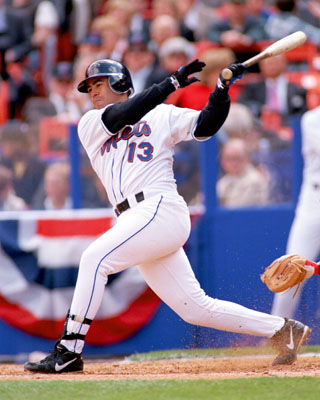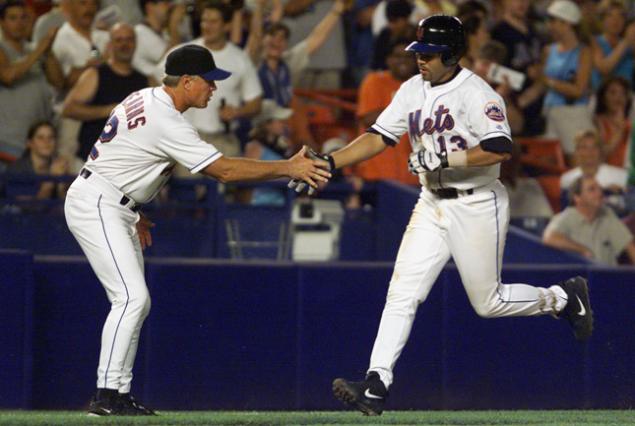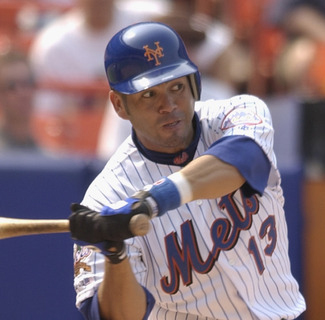 Edgardo Alfonzo remains one of the most beloved Mets alumni, both for his post-season heroics (e.g. 3 HR’s including a ninth inning grand slam in the space of two vital 1999 playoff games against the Reds and Diamondbacks), and his role as part of the “Best Infield Ever” as dubbed by Sports Illustrated. His flexibility as a player made him an invaluable asset to the team which moved him from his original spot at second base over to third, back to second upon the signing of Robin Ventura, and then to third again with the trade that brought Roberto Alomar into the fold. Despite a modicum of grousing due to all the defensive shifts, he provided consistent quality play during one of the upswing periods in Mets history.
Edgardo Alfonzo remains one of the most beloved Mets alumni, both for his post-season heroics (e.g. 3 HR’s including a ninth inning grand slam in the space of two vital 1999 playoff games against the Reds and Diamondbacks), and his role as part of the “Best Infield Ever” as dubbed by Sports Illustrated. His flexibility as a player made him an invaluable asset to the team which moved him from his original spot at second base over to third, back to second upon the signing of Robin Ventura, and then to third again with the trade that brought Roberto Alomar into the fold. Despite a modicum of grousing due to all the defensive shifts, he provided consistent quality play during one of the upswing periods in Mets history.
As a batsman, Fonzie developed in almost textbook fashion before the delighted eyes of fans. Coming up, he had a reputation for a good eye at the plate, some evidence of moderate power, and the ability to make contact. Following his major league debut in 1995, the young Venezuelan worked diligently to refine his game both in the field and at the plate. By 1999, he had blossomed into one of the league’s premier middle infielders, hitting over .300 and slugging over .500 for the first time in his career. His peak game, and likely the peak offensive game by any Met, came in late August of that year as the Mets were heading toward a post-season berth under the guidance of Bobby Valentine.
The team was in Houston for a series against the Astros during their last go-round in the vast dimensions of the Astrodome. The following year, the team would move to the bandbox originally known as Enron Field (or “Ten Run Field” to fans for its propensity to produce high scoring games) and now dubbed Minute Maid Park. In stark contrast to the home run haven the Astros now inhabit, the ‘Dome was a pitcher’s dream and a slugger’s graveyard. Not only was the field characterized by expansive proportions, the roof insured that the very atmosphere itself was endowed with what batters swore was a deadening effect. But it was in this most unlikely of settings that the Mets’ version of the Fonz chose to put on perhaps the greatest display of slugging in team history.
1999 was a bumper year for runs scored by the Mets as they pushed 853 across the plate, good for 5th in the league and still the club record for a single season. Even 40 year-old leadoff batter Rickey Henderson was having a renaissance year, batting over .300 for the first time since in four campaigns. On the night of August 30 of that year, the team would rack up a run tally that was impressive even by the standards of that era, blasting the Houston squad by a score of 17-1.
The key figure in the onslaught was Edgardo Alfonzo who began his evening by rocketing a solo home run his first time up to give the Mets an early lead. After the Astros were retired in order in the bottom of the first, the New Yorkers erupted for six additional runs in the next inning with Alfonzo contributing a single and a run scored in the process. He then homered in his next two at-bats registering a two-run shot in the fourth and another solo round-tripper in the sixth. After collecting his second single of the game in the eight amidst another rally, he came up for a final time in the ninth. Urged by his teammates to shoot for the elusive 4-homer mark, he banged a shot off the right field wall for a run-scoring double, missing another 4-bagger by a matter of a few feet.
All told, Fonzie had recorded 6 hits in as many at-bats including 3 HR’s and a double. In the process he set Mets club records for hits, runs, and total bases in a game as well as collecting 5 RBI. Naturally, his performance set off the stat freaks at Elias who determined that the only other player to accomplish a comparable feat was none other than Ty Cobb some 74 years prior when he also recorded a 3 homer, 1 double, 2 single game against the St. Louis Browns.
Fonzie and Cobb, Cobb and Fonzie. A rather exclusive club with one member a Met.
















